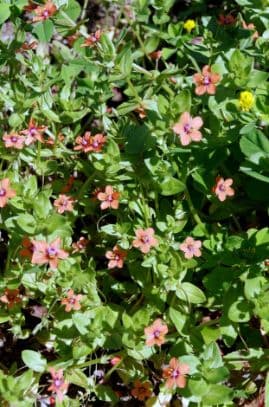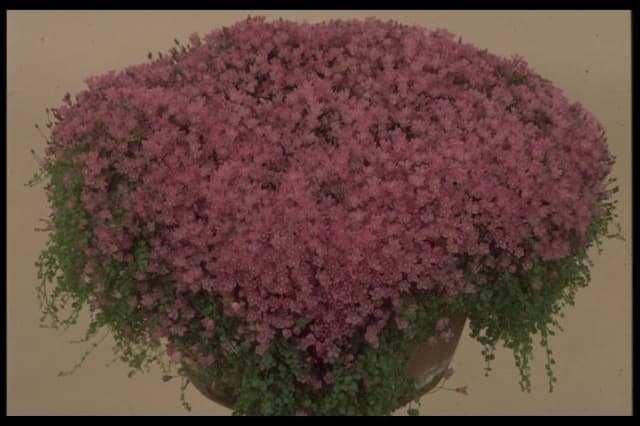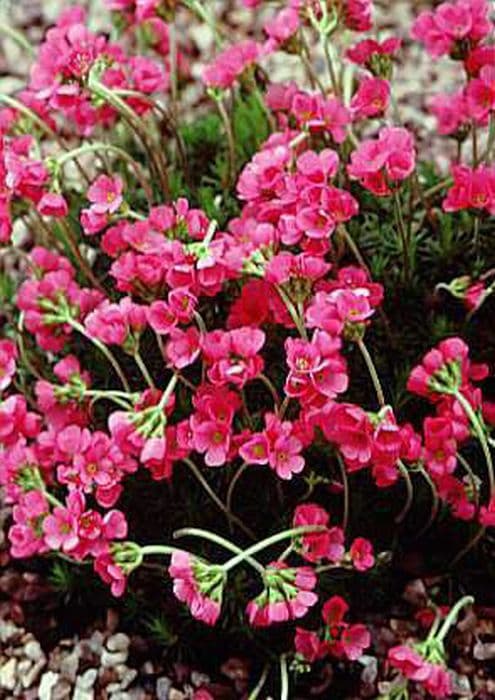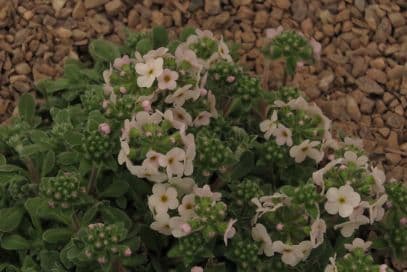Cushion Primrose Primula marginata 'Beamish' (Au)

ABOUT
Primula 'Beamish' (Au) is a charming perennial plant that graces gardens with its lovely features. Its leaves are intricately shaped, with a decorative, scalloped edge that captures the eye. The foliage has a soft, powdery look, enhancing its visual appeal. During the blooming period, the plant produces a profusion of delightful flowers. These blossoms are typically a vibrant shade that stands out beautifully against the foliage. Each flower consists of a rounded, central eye surrounded by smaller petals arranged in a circular pattern, giving it a classic and appealing look. The stems of the flowers rise just above the foliage, creating a delightful contrast of color and texture. This plant has a neat, mounded habit, which adds to its ornamental value in any garden setting. The charm of Primula 'Beamish' (Au) lies not just in its blooms but also in its leaves, which maintain their attractiveness throughout the growing season. The foliage may have a hue that contrasts with the flowers, adding depth and interest to its already enchanting appearance. Overall, the plant presents itself as a compact, lush cluster of leaves and flowers that work together to create a captivating visual display.
About this plant
 Names
NamesFamily
Primulaceae
Synonyms
Cushion Primrose, Silver-Edged Primrose
Common names
Primula marginata 'Beamish' (Au)
 Toxicity
ToxicityTo humans
The plant commonly known as Cushion Primrose is generally considered safe around humans. However, as with many plants, sensitivity varies from person to person, and it can cause mild irritation if ingested or if the sap comes into contact with skin, particularly for those with sensitive skin or allergies. If ingested, symptoms of irritation may include mild gastrointestinal distress, such as nausea or an upset stomach. It's important to keep in mind that any plant material accidentally consumed could cause discomfort due to the presence of unfamiliar compounds.
To pets
Cushion Primrose is not known to be toxic to pets. However, ingestion of plant material can potentially lead to gastrointestinal upset in some animals, similar to humans. This can include symptoms like vomiting or diarrhea. If your pet is known to nibble on plants, it's best to prevent them from ingesting this or any plant to avoid potential irritation or an allergic reaction. If a pet does consume parts of the Cushion Primrose and exhibits signs of distress, it is advised to consult a veterinarian.
 Characteristics
CharacteristicsLife cycle
Perennials
Foliage type
Evergreen
Color of leaves
Green
Flower color
Blue
Height
6 inches (15 cm)
Spread
8 inches (20 cm)
Plant type
Herb
Hardiness zones
5
Native area
Europe
Benefits
 General Benefits
General Benefits- Ornamental Appeal: Adds visual interest to gardens with its attractive rosettes of silvery foliage and early spring blooms.
- Compact Size: Ideal for rock gardens, alpine troughs, and small spaces due to its small, manageable size.
- Low Maintenance: Requires minimal care once established, making it a good choice for low-maintenance landscapes.
- Drought Tolerance: Once established, it has a good level of drought resistance, making it suitable for drier climates and water-wise gardens.
- Cold Hardy: Can withstand cold temperatures, making it suitable for gardens in cooler climates.
- Attracts Pollinators: Flowers can attract bees and butterflies, supporting local ecosystems.
- Seasonal Interest: Provides early spring flowers when not much else is in bloom, offering seasonal interest in the garden.
 Medical Properties
Medical PropertiesThis plant is not used for medical purposes.
 Air-purifying Qualities
Air-purifying QualitiesThis plant is not specifically known for air purifying qualities.
 Other Uses
Other Uses- As a dye source: The flowers of the Primula marginata 'Beamish' can be used to create a natural dye for fabrics, providing a range of hues from pale yellow to green.
- In art and craft: Its vibrant leaves and flowers can be pressed and included in botanical prints or used to adorn hand-made paper.
- Photography subject: Due to its unique appearance and lovely blooms, it can be an excellent subject for botanical photographers and hobbyists.
- Educational tool: This plant can be used in educational settings to teach botany and the importance of plant diversity.
- In culinary display: Although not edible, its flowers can be used to decorate food plates or buffet tables at functions for an elegant touch.
- Garden design: Can be used to create a 'living' edge in gardens, providing a natural border that is both beautiful and functional.
- Companion planting: Its ability to bloom in early spring makes it a perfect companion plant to underplant later-flowering species in a mixed border.
- As a natural pest deterrent: When planted in a garden, Primula marginata 'Beamish' could potentially help deter certain pests through its natural properties.
- Cultural symbol: In specific cultures, it could be used as a symbol in ceremonies or traditions due to its striking visual appeal.
- Frost indicator: This hardy plant can act as an indicator of late-season frosts for gardeners, as it can tolerate cold but may show signs of stress when temperatures drop suddenly.
Interesting Facts
 Feng Shui
Feng ShuiThe Primula is not used in Feng Shui practice.
 Zodiac Sign Compitability
Zodiac Sign CompitabilityThe Primula is not used in astrology practice.
 Plant Symbolism
Plant Symbolism- Youthful Charm: The Primula, commonly known as the Primrose, is often linked to the idea of youth and early life due to its early spring blooming, representing new beginnings and innocence.
- Hope: Emerging after the cold winter months, Primroses symbolize hope and the anticipation of joy to come.
- Love and Affection: Given their delicate and attractive blooms, Primroses are also often associated with expressions of love, care, and affection.
- Protection: In folklore, Primroses are believed to provide protection against evil spirits and are planted around homes for this purpose.
- Eternal Existence: Because of their perennial nature, returning year after year, Primroses can symbolize the concept of eternal life or existence.
 Water
WaterThe cushion primrose should be watered regularly to keep the soil consistently moist but not waterlogged. During the growing season, water the plant thoroughly once a week with about 8-16 ounces of water, depending on the size of the pot and the environmental conditions. Reduce watering in the winter when the plant is not actively growing. Ensure the pot has good drainage to prevent root rot. Adjust the watering frequency based on the plant's location and temperature, as indoor heated air or full sun can dry out the soil faster.
 Light
LightThe cushion primrose thrives in bright, indirect light. It should be placed in a spot where it receives dappled sunlight or partial shade. Avoid direct afternoon sun as it can scorch the leaves. A north-facing or east-facing window is often ideal as it provides the soft light this primrose prefers.
 Temperature
TemperatureThe cushion primrose prefers cool to moderate temperatures, with an ideal range between 50°F and 70°F. It can survive minimum temperatures down to about 40°F, but not prolonged periods of freezing conditions. Avoid exposing the plant to temperatures above 80°F, as this can lead to heat stress.
 Pruning
PruningPrune the cushion primrose to remove dead or yellowing leaves and spent flowers, which encourages new growth and maintains its attractive appearance. The best time for pruning is immediately after flowering. Prune lightly, as needed, to keep the plant compact and healthy. Pruning can be done every few weeks during the flowering period.
 Cleaning
CleaningAs needed
 Soil
SoilCushion Primrose prefers well-draining, gritty soil with good organic content. The ideal soil mix for Primula marginata 'Beamish' can be created by combining equal parts of loamy garden soil, peat or leaf mold, coarse perlite or sharp sand, and small gravel to increase drainage. The plant thrives in slightly alkaline to neutral pH, around 7.0 to 7.5.
 Repotting
RepottingCushion Primrose should be repotted every one to two years to refresh the soil and accommodate root growth. It is best repotted in the spring after flowering when it has completed its winter dormancy.
 Humidity & Misting
Humidity & MistingCushion Primrose benefits from moderate humidity levels but is quite tolerant of different conditions. Aim for humidity levels between 50-60% for optimal growth and flowering.
 Suitable locations
Suitable locationsIndoor
Provide bright light, cool temps, and moderate humidity.
Outdoor
Partial shade, protect from hot sun, moist well-drained soil.
Hardiness zone
5-8 USDA
 Life cycle
Life cyclePrimula marginata 'Beamish' (Au), commonly known as Cushion Primrose, begins its life cycle with seed germination, which typically occurs in moist, well-draining soil during cooler temperatures of late winter to early spring. Seedlings emerge, developing into a rosette of spoon-shaped, silver-rimmed leaves that are evergreen, contributing to ground cover. Throughout the spring, stalks rise from the rosette, bearing clusters of purple flowers with yellow centers that are bee-friendly and offer a vital nectar source. After pollination, usually by insects, the flowers produce seeds that mature by late summer, allowing for propagation and dispersal. As a perennial, the Cushion Primrose enters a period of dormancy in winter, enduring cold temperatures before resuming growth in the following spring. This cycle continues annually, with the plant expanding in size and potentially living for several years if conditions are favorable.
 Propogation
PropogationPropogation time
Spring-Early Summer
Propogation: Primula marginata 'Beamish', commonly known as the Cushion Primrose, is best propagated through division, a method that is typically carried out in late winter or early spring. To propagate by division, carefully lift the parent plant from the ground, ensuring to keep a good amount of soil around the roots. Gently tease apart the crowns of the plant, making sure that each division has a section of roots attached. After dividing, promptly replant the divisions at the same depth they were growing originally, spacing them about 6 to 8 inches (15 to 20 centimeters) apart to allow for adequate air circulation and growth. Water the new plantings thoroughly to help establish them. Over time, these divisions will grow into mature plants that mirror the characteristics of the parent 'Beamish' specimen.









